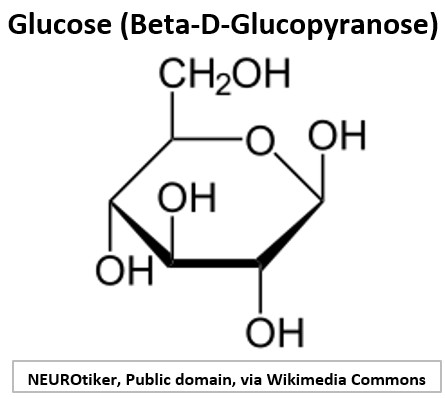Menu (linked Index)
Cellular Respiration (II) Glycolysis
Last Update: October 29, 2024
Introduction
This is part II of a 5 part series on Cellular Respiration. You can access the other posts via the links below.
- Cellular Respiration (I) Overview
- Cellular Respiration (II) Glycolysis
- Cellular Respiration (III) Pyruvate to Acetyl CoA
- Cellular Respiration (IV) Krebs Cycle
- Cellular Respiration (V) Oxidative Phosphorylation
In this post we’ll cover the multiple reaction steps of Glycolysis, the first stage of Cellular Respiration.
Glycolysis starts with glucose or similar sugars, breaks them down, creates energy carrying molecules like ATP and NADH, and also produces Pyruvate.
These reactions occur in the cytoplasm of cells and dont require oxygen.
Pyruvate converts to Acetyl Co, which kicks off the Krebs Cycle, the next phase of Cellular Respiration. This Pyruvate to Acetyl CoA conversion is sometimes called the Transition Phase of Cellular Respiration.
Glycolysis
Take a look at the Central Metabolism sketch shown below.
Glycolysis is typically described in text books as a two phase process.
- The glucose molecule is first destabilized (Investment Phase)
- The first four circles in the drawing
- and then split up (Payoff Phase) into two pyruvate molecules.
- the following six circle path (starting with G3P) in the drawing,
- or the following seven circle path (starting with DHAP);
- with each path producing 1 Pyruvate (for a total of 2)
Picture_Central Metabolism
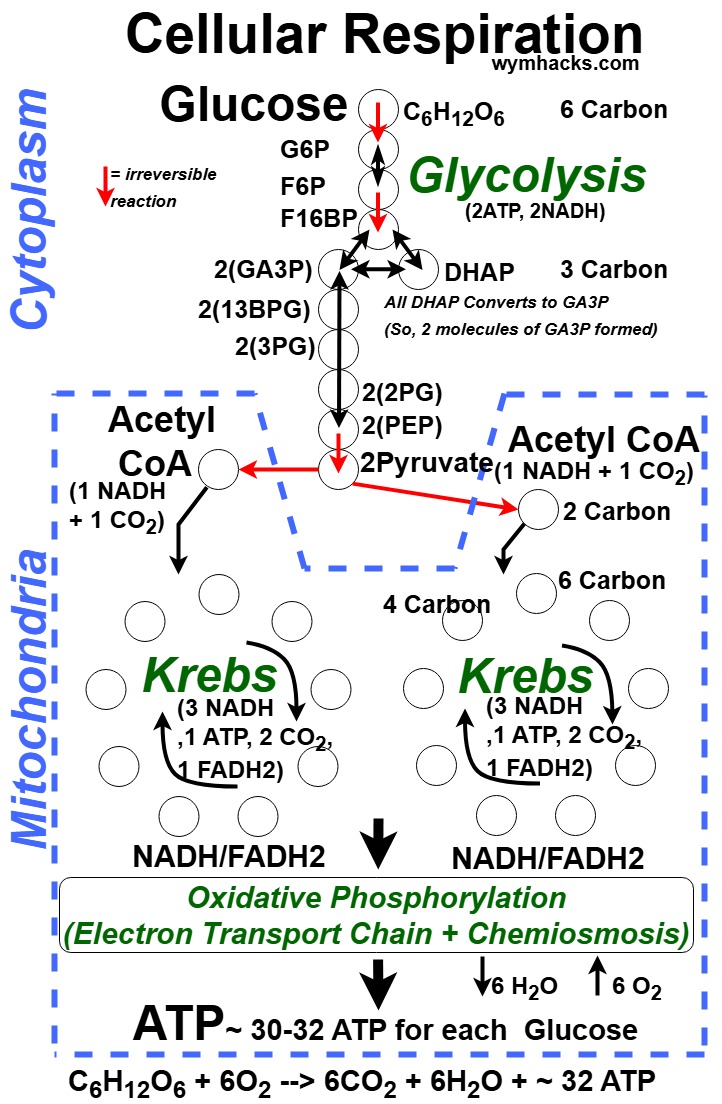
Glycolysis – Investment Phase
- Glucose, is a 6-carbon sugar molecule that, in our bodies, is usually found in its cyclic form.
- It contains hydroxyl groups (OH)
- and an aldehyde group (H-C=O) at one end.
Picture_Glucose

- Each circle in the Central Metabolism picture is a symbol for Glucose
- or several of the intermediate chemicals along the Cellular Respiration pathway.
- The first step of cellular respiration is called Glycolysis (i.e. the breaking down of glucose)
- which itself can be broken down into two phases.
- 1 molecule of glucose is phosphorylated and effectively rendered more reactive (unstable)
- This is called the Energy Requiring or Investment Phase.
- The resultant molecule is called Fructose-1,6-Bisphosphate (F16BP)
- F16BP is the fourth circle in the Central Metabolism drawing.
- Two molecules of ATP were used to provide energy for these steps
- ATP + H2O -> ADP + Pi + energy where Pi depicts a phosphate group.
Glycolysis – Payoff Phase
- The following steps are called the Energy Releasing Phase or Payoff Phase.
- F16BP splits into two 3 carbon molecules which are isomers of each other (DHAP and G3P).
- Much smaller amounts of DHAP will exist
- and these will convert to G3P eventually.
- The reaction pathway continues downward (in our Central Metabolism drawing) after G3P (Glyceraldehyde -3- Phosphate).
- The drawing shows that for each molecule of Glucose , there will be a duplicate reaction train,
- eventually producing 2 molecules of pyruvate.
- In the Payoff Phase,
- 4 ATP were created (via ADP + Pi + energy -> ATP + H2O)
- and 2 NADH were created.
- Since the Investment Phase consumed 2 ATP, and the Payoff Phase created 4 ATP ,
- we have a net production of 2 ATP.
- ATP and NADH are really important molecules.
- They are some of the key energy carriers in the body
- where ATP is the desired final energy carrier and
- NADH assists in the creation of more ATP later on in the process.
We’ve already described the amazing structure of ATP.
So, what does NADH look like?
NADH – Nicotinamide Adenine Dinucleotide
Picture_NADH – Nicotinamide Adenine Dinucleotide
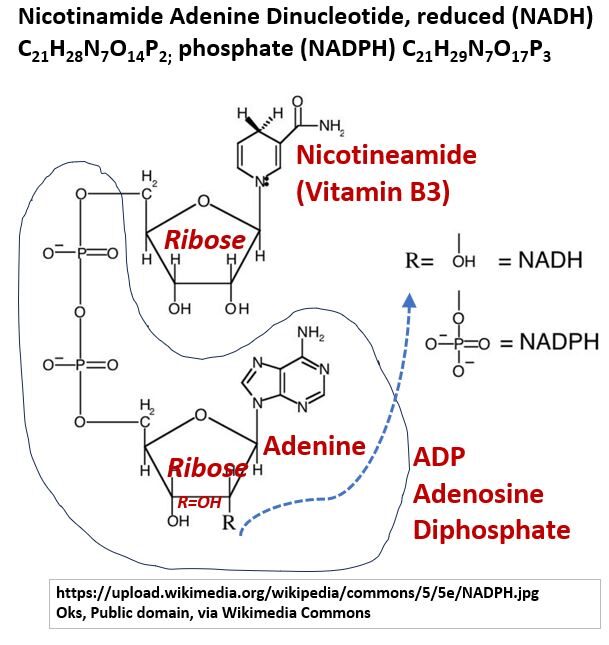
- The NADH molecule has a lot of familiar parts!
- Those adenine , ribose, and phosphate groups seem to be everywhere. (DNA, RNA, ATP, ADP).
- If the R group is a phosphate then NADH becomes NADPH (Nicotinamide Adenine Dinucleotide Phosphate)
- There is a whole ADP nucleotide molecule in it (a moiety).
- NADH also has a Vitamin B3 moiety in it.
- Without Vitamin B3 (which we have to get from out diet), the body cannot make NAD+
- NAD+ is the pre-reduced version of this molecule.
- NADH is an electron carrier.
- NAD+ molecules in the body accept hydrogen and electrons (are reduced) to form NADH.
In the picture below, I show the NAD+ to NADH reaction (note: the ADPs in the drawings are the circled section above).
Picture_NAD Oxidation Reduction Reaction
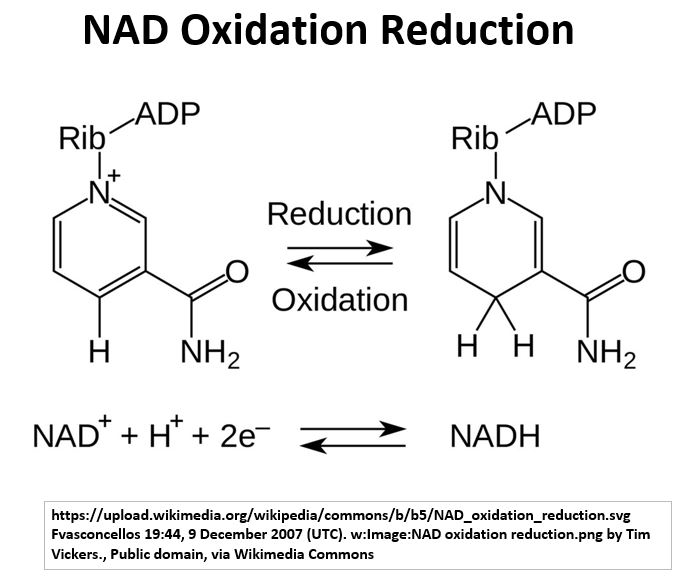
- The electrons are carried by NADH and delivered to the Electron Transport Chain.
- NADH is a co-enzyme since it works with enzymes to deliver electrons.
Ok, lets continue with the final Glycolysis step.
The final step of Glycolysis Produces Pyruvates
- Pyruvate is the end product of glycolysis.
- In the simplified Central Metabolism drawing, this is represented by the 10th circle
- if we count vertically and assume we have the G3P starting reaction
- or the 11th circle if we assume DHAP first converts to G3P.
- For each molecule of Glucose, 2 molecules of Pyruvate are produced.
- Pyruvate is a 3 carbon molecule which is no longer a sugar. See the reaction below.
Picture_Glycolysis: 1 Glucose to 2 Pyruvates
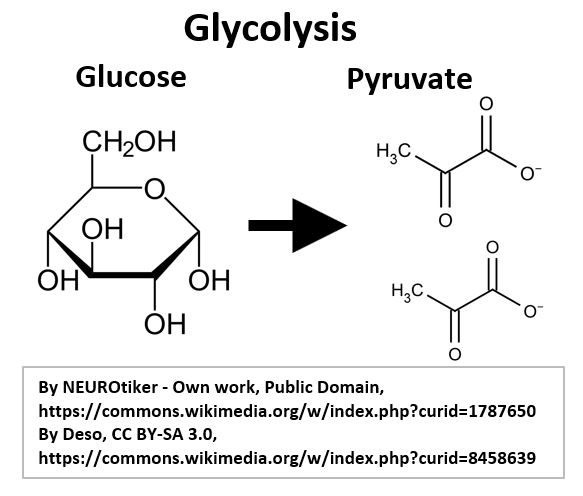
Glycolysis is an Anaerobic Process
Glycolysis does not need oxygen and therefore the process is anaerobic.
However, the subsequent Krebs Cycle and Electron Transport Chain stages do need Oxygen and are therefore aerobic processes.
In fact, in limited O2 or no O2 situations (e.g. you are maxing out those bicep curls or you are doing sprints), Pyruvate will react to produce Lactic Acid in a process called Fermentation.
Glycolysis – It’s Complicated and Highly Regulated by the Body
- So, the overall Glycolysis reaction looks like :
- Glucose + 2 NAD(+) + 2ADP + 2Pi -> 2 Pyruvate + 2 NADH + 2 ATP
- where Pi = phosphate group
- Glycolysis produces a net of 2 ATPs and 2 NADHs.
- Each step of glycolysis involves specific enzymes, and
- the whole process is regulated by various hormones (e.g. Insulin, Glucagon)
- In many textbooks, glycolysis is described as a 10 step process.
- See the more detailed picture below showing all the major intermediate chemicals and enzymes involved in glycolysis.
Picture_Glycolysis / Gluconeogenesis Pathways

- Notice that reactions can proceed from Glucose to Pyruvate but
- also can proceed in reverse from various starting points to Glucose.
- The process of Glucose formation from Lactic Acid, Amino Acids, and fat (Glycerol) is called Gluconeogenesis.
- Gluconeogenesis is essentially the reverse of Glycolysis.
- It overcomes the three irreversible steps of Glycolysis with the help of unique enzymes (blue lines).
- Use the drawing above to see the detailed step by step reactions including enzymes involved.
- The drawing below gives you a cleaned up simplified view
- What the drawings don’t show are the hormones that regulate these processes (main ones being Insulin and Glucagon)
Picture_Glycolysis / Gluconeogenesis Pathways Simplified
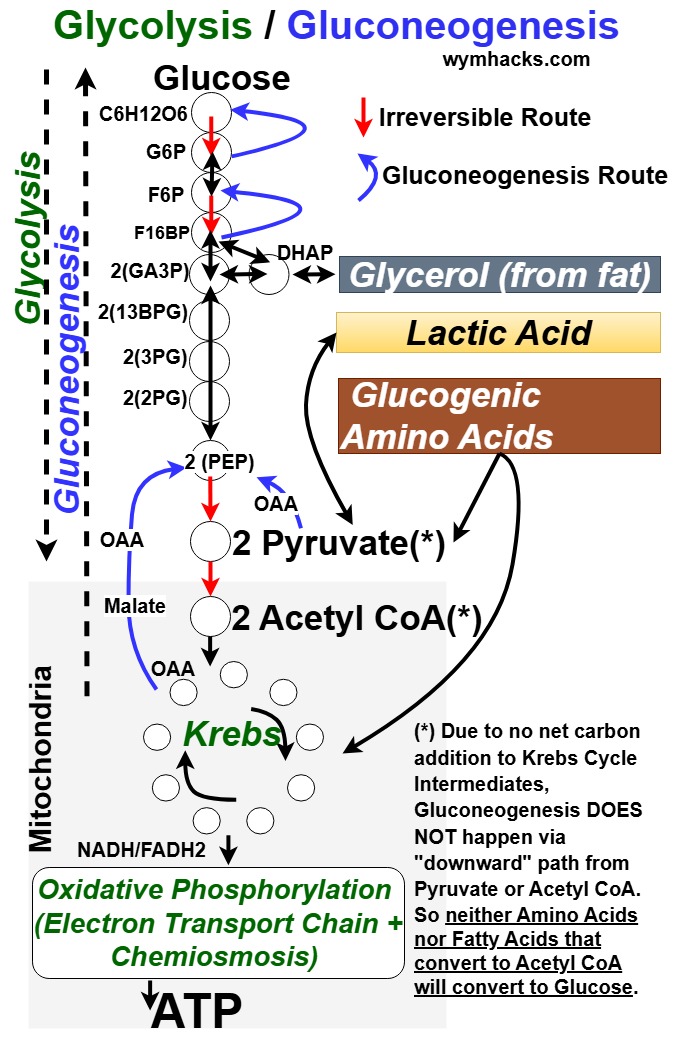
- In a Fasting State (i.e. your body doesn’t have enough glucose),
- the body will produce glucose from other non-carbohydrate nutrients
- Gluconeogenesis allows this to happen.
- Specific enzymes are employed here (and in every other step in cellular respiration).
- The hormone Insulin triggers Glycolysis (in a Fed Metabolic State) while
- the hormone Glucagon triggers Gluconeogenesis (in a Fasting Metabolic State).
- For limited or no Oxygen conditions (anaerobic conditions),
- Pyruvate acts as an electron acceptor and converts NADH to NAD+
- Lactic Acid is produced in the process (called Fermentation).
- Helps supply NAD+ when the Electron Transport Chain is limited in its NADH to NAD+ regeneration.
- But in “normal conditions” the Pyruvates (2 for each glucose molecule)
- convert to Acetyl CoA (where more NADH is made)
- which enter the Krebs cycle (where even more energy molecules are made).
- Your body is an amazing, complicated machine.
Conclusion
Glycolysis is a metabolic pathway that breaks down simple sugars into Pyruvate molecules.
These reactions occur in the cytoplasm of cells and don’t require oxygen.
- Glycolysis produces 2 NADH and 2 ATP.
- The NADH is an electron carrier and is used in the the last stage of Cellular Respiration to make more ATP (Electron Transport Chain).
Glycolysis reactions represent the First Stage of Cellular Respiration. In the remaining stages,
- Pyruvate is converted to Acetyl CoA which enters the Krebs Cycle.
- The Krebs Cycle produces ATP and Electron Carrier Molecules.
- The Electron Transport Chain takes the Electron Carrier Molecules and makes a lot more ATP.
The next stage of Cellular Respiration is the Pyruvate to Acetyl CoA Transition step. You can read more about that via the link below.
Provided below are some great Glycolysis / Gluconeogenesis references:
- Video: Overview of glycolysis-Khanacademy.org
- Document: Glycolysis-Khanacademy.org
- Videos: Gluconeogenesis 1, Gluconeogenesis 2 – Khanacedymy.org
- Video:Cellular respiration-Khanacademy.org
- Video:Cellular respiration introduction-Khanacademy.org
- Video: Overview of cellular respiration-Khanacademy.org
- Document: Introduction to cellular respiration and redox-Khanacademy.org
- Document: Steps of cellular respiration-Khanacademy.org
Disclaimer: The content of this article is intended for general informational and recreational purposes only and is not a substitute for professional “advice”. We are not responsible for your decisions and actions. Refer to our Disclaimer Page.
